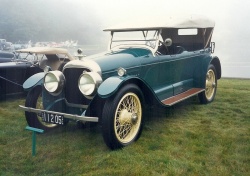 1916 Cunningham. Click image to enlarge |
Article and photo by Bill Vance
Until the Ford Motor Company accomplished it in 1966, America had never won the world’s most prestigious road race, the 24 hours of Le Mans, France, held since 1923. Winning there and having one’s national anthem played was road racing’s highest honour.
The closest American cars had come was second and third by Stutz and Chrysler respectively in 1928. Briggs Swift Cunningham of Connecticut was determined to change that, and he wanted to win Le Mans with a car using totally American components.
Cunningham was born in 1907 in Cincinnati, Ohio, to a family of considerable wealth. His mother had inherited investments in railroads and utilities and his father was one of the original financers of Procter and Gamble. After a couple of years studying engineering at Yale, Briggs left, got married, honeymooned in Europe and generally lived a gentleman’s life. He was interested in both car and yacht racing, and would excel in both by rising to the top in yachting, and almost to the top in car racing.
Following the Second World War, Cunningham began seriously pursuing auto racing. This brought him into contact with a couple of enthusiastic racers/garage owners from Long Island, New York named Phil Walters and Bill Frick. They were masters of engine swapping; one of their specialties was dropping Cadillac engines into Fords to produce “Fordillacs.”
Cunningham was so intrigued with the Fordillac he tried to enter one in the 1950 Le Mans race. When the hybrid wasn’t eligible he entered two 1950 Cadillacs, one almost stock and the other fitted with an aerodynamic, rectangular body designed by some Grumman engineers. The French quickly dubbed it Le Monstre. They did surprisingly well, the stock Cadillac finishing 10th and Le Monstre 11th, convincing Cunningham that he could win Le Mans with a proper American racing car.
Cunningham moved the Frick-Walters operation to West Palm Beach Florida where it became the B.S. Cunningham Co. Work began immediately on three racers for 1951. Since Chrysler was the only American manufacturer that offered substantial help, Cunningham used Chrysler’s new 5.4-litre overhead valve “Hemi” V8. They hopped it up from the stock 180 horsepower to 220 with four carburetors. It also got higher compression, reportedly achieved by fitting Cadillac pistons!
The first prototype was the C-1, followed by the C2, three of which would be sent to Le Mans. Besides the engine, the shock absorbers and steering were Chrysler. Oldsmobile rear springs were used plus a Ford front end and Cadillac brakes. The whole thing was fitted with a bulbous but not unattractive roadster body.
The three cars were finished so late their only testing was the drive from Florida to New York for shipment to France. Two C-2s failed to finish the 1951 race but a third held second place for five hours, finally coming in 18th due to valve problems caused by the inferior fuel provided. It was not an auspicious start but it encouraged Cunningham enough to continue.
To satisfy the racing authorities that he was a production car builder, Cunningham built 27 beautiful C-3 Italian-bodied, road-going Cunninghams. This cleared the way for his next real racer, the C-4R, which was smaller and lighter than the C-3 but still used the Chrysler engine, now up to 325 horsepower. The C-4R would prove the most durable of all Cunninghams. Two C-4R roadsters and a coupe were entered in the ’52 Le Mans. Two failed to finish, but the third, driven for almost 20 hours by Briggs Cunningham himself, came in fourth.
Cunningham returned to Le Mans in 1953 with a C-4R roadster, a C-4RK coupe and a new C-5R. The C-5R was fitted with an unusual solid front axle and huge, 17-inch (432 mm) brake drums. In spite of their size these drums were no match for the Jaguar’s outstanding new disc brakes, and the C-5R finished third behind two Jags. The other C-4Rs were seventh and tenth.
For 1954 Cunningham was back at Le Mans, and with a bow to European technology he brought a re-bodied Ferrari which failed to finish. Two of the venerable C-4Rs were third and fifth.
Cunningham returned to Le Mans in 1955 with the lighter, Offenhauser-powered C-6R but it too failed to finish. This was his last attempt to win Le Mans with American equipment, which unfortunately was becoming increasingly outclassed.
Although he never would hear the Star Spangled Banner played over his cars at Le Mans, it had been a valiant attempt by a privateer against the might of Europe’s factory teams. It took the Ford Motor Co.’s huge resources to build the Ford GT-40s which paved the way for American cars to win Le Mans in 1966, ’67, ’68 and ’69.
Briggs Cunningham did, however, go on to win something for his country: he piloted the 12-metre yacht Columbia to victory in the 1958 America’s Cup Challenge race.








